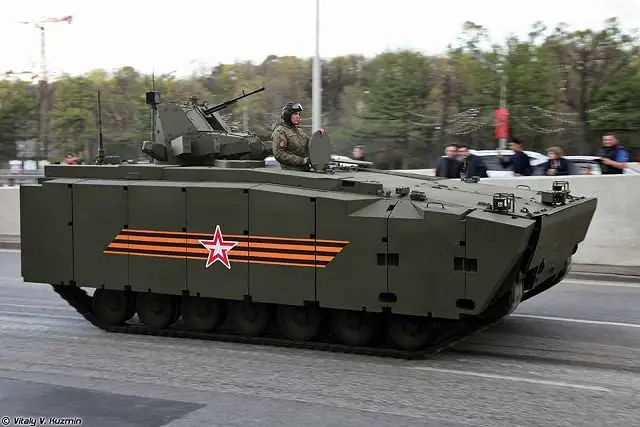| a | |||||
|
|
|||||
|
Defence & Security News - Russia
|
|||||
|
|
|||||
| Russian MoD plans to product a family of combat vehicles based on Kurganets-25 platform | |||||
|
The Russian MoD plans to create a family of combat vehicles based on the Kurganets-25 standardized platform, a Russian defense industry source told TASS. "It is planned to use the Kurganets-25 medium platform for creating a mobile reconnaissance post MRP, a mobile command and staff vehicle chassis, a chemical reconnaissance vehicle and a 120 mm self-propelled artillery system," the source said, noting the multirole capability of Kurganets.
|
|||||
|
|
|||||
 Kurganets-25 BTR armored personnel carrier variant Kurganets-25 BTR armored personnel carrier variant |
|||||
|
|
|||||
|
Probably, the Kurganets-25 platform is going to be used for creating a self-propelled mount fitted with a 120 mm 2A51/2A60/2A80 mortar cannon system. In this case the new weapon will perform on the battlefield the functions currently assigned to the 2S9 Nona self-propelled artillery system on BMD-1/2 chassis, 2S23 Nona-SVK on BTR-80 chassis and 2S31 Vena on BMP-3 chassis. The special feature of 2A51/2A60/2A80 cannons is their capability to fire 120 mm mortar mines of both Russian and foreign manufacture /including rocket-assisted projectiles. It is allowed to use KM-8 Gran guided mine developed by Instrument Design Bureau of Tula KBP. These cannons can fire 3VBK14 shaped charge round whose armor penetration reaches 600 mm. This makes it possible, if necessary, also to defeat heavy armor /including main battle tanks at a distance of up to 1 km.
The 2A51/2A60/2A80 cannon firing range is 7.1 to 14 km depending on the type of ammunition used. This implies their use on the battlefield as a direct support of motorized rifle units in defense and offense. Originally, the 2S9 Nona self-propelled gun SPG was developed for airborne troops. This enables it to use NATO countries’ mines, which partially resolves the problem of ammunition shortage in the event of seizure and holding of a bridgehead by airborne troops in the enemy’s rear. The combat operation of Nona in mountainous areas of Afghanistan and Chechnya demonstrated the SPG fortes what proved particularly advantageous was the cannon’s large elevation angle, from -4 to +80 degrees, which enabled neutralizing the foe in mountainous positions. The subsequent modification of the system Nona-SVK was used as the basic chassis for fitting the BTR-80 APC designed for operation with motorized rifle units. The 2S23 Vena system, based on BMP-3, was created for the same purpose. The new modification of the cannon is being developed based on the BMP Kurganets-25 which graphically shows the transition of 2A51/2A60/2A80 from the assault groups’ support weapon to the motorized rifle units’ arsenal. It is unknown now whether a modernized 2S9 version will be created for airborne troops. But considering the trends in the development of this armed service, the creation of such a piece of armament is not unlikely, in which case the platform will probably be provided by the BMD-4 or BMD-4M amphibious infantry fighting vehicle. Also, it is planned to create, based on Kurganets-25, a self-propelled air defense system SPADS, the source informed. "The Kurganets-25 standardized medium tracked platform is going to be used for creating a family of innovative floating armored vehicles. Preparations are made for cooperation with lead developers of examples of this family and readiness is demonstrated for tailoring the platform to their demands. For instance, it is planned to create a combat vehicle of the air defense artillery system, caliber 57 mm," the source said. He did not specify if the system would be fitted with air defense guided missiles. At present, in service with motorized rifle units are tracked 2S6/2S6M (2K22/2K22M) air defense gun and missile systems Tunguska/Tunguska-M and wheeled 96K6 Pantsir-S. They use two 30 mm air defense automatic guns 2A38/2A38M as an artillery armament, and 9M311/9M311M/9M311-1M and 57Ee6E air defense guided missiles as rocketry. Some military units have preserved 2A6 ZSU-23-4/ZSU-23-4M3 Shilka/Biryusa weapon systems armed with the quadruple 23 mm AZP-23 Amur anti-air automatic gun. There is a model of Shilka fitted with Strelets air defense missile system, dubbed ZSU-23-4M4 Shilka-M4. The Shilka systems in the Russian Armed Forces are gradually being replaced by more advanced weapons. The 57 mm anti-air gun has been used in the design of Soviet/Russian SPAD only once, in the component package of ZSU-57-2 based on the T-54/55 tank built from 1955 to 1960. ZSU-57-2 got two 57 mm AZP-57/S-60 guns. This system was later found ineffective for lack of radar equipment and low firing rate of the AZP-57 gun. It was decided to lessen the anti-air gun caliber and essentially increase its firing rate. The 57 mm gun is also used to arm the AU-220M fighting module with which probably the Russian advanced armor will be armed. The source did not disclose the details of designing Kurgenets-25-based vehicles for command and staff roles, mobile reconnaissance functions and chemical reconnaissance missions. Kurganets-25 platform is in the same series as the heavy Armata, medium Boomerang and light Typhoon. By now an infantry fighting vehicle has been created on its basis, demonstrated at the Victory Parade in Moscow on May 9. The series production of this armored vehicle may start as early as 2017-2018. |
|||||
| © Copyright 2015 TASS. All rights reserved. This material may not be published, broadcast, rewritten or redistributed. | |||||















